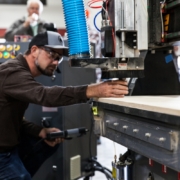U.S. Must Stop Trafficking of Counterfeit & Pirated Goods
One of the dangers of reliance on foreign manufacturers is the increase of U.S. vulnerability to receiving counterfeit goods. Over the last ten years, there have been several reports prepared to determine the extent of the infiltration of counterfeits into U.S. defense and industrial supply chains, to provide an understanding of industry and government practices that contribute to the problem, and to identify best practices and recommendations for handling and preventing counterfeit electronics.
The first was the Defense Industrial Base Assessment: Counterfeit Electronics prepared by the U.S. Department of Commerce in January 2010 as a result of a three-year study. “This assessment focused on discrete electronic components, microcircuits, and circuit board products – key elements of electronic systems that support national security, industrial, and commercial missions and operations. A few of the findings of the study were:
- counterfeit electronics have directly impacted all elements of the supply chain
- companies and organizations assume that others in the supply chain are testing parts;
- lack of traceability in the supply chain is commonplace
- there is an insufficient chain of accountability within organizations
- recordkeeping on counterfeit incidents by organizations is very limited
- most DOD organizations do not have policies in place to prevent counterfeit parts from infiltrating their supply chain
The Bureau of Industry and Security’s (BIS) Office of Technology Evaluation (OTE) made the following key recommendations:
- Consider establishing a centralized federal reporting mechanism for collecting information on suspected/confirmed counterfeit parts for use by industry and all federal agencies
- Modify Federal Acquisition Regulations (FAR), including Defense Federal Acquisition Regulations (DFAR), to allow for “best value” procurement.
- Require U.S. Government suppliers and federal agencies to systematically report counterfeit electronic parts to the national federal reporting mechanism;
- Issue clear, unambiguous legal guidance to industry and U.S. federal agencies with respect to civil and criminal liabilities, reporting and handling requirements
- Establish federal guidance for the destruction, recycling, and/or disposal of electronic systems and parts sold and consumed in the United States.
- Consider establishing a government data repository of electronic parts information and disseminating best practices to limit the infiltration of counterfeits into supply chains.
- Develop international agreements covering information sharing, supply chain integrity, border inspection of electronic parts shipped to and from their countries, related law enforcement cooperation, and standards for inspecting suspected/confirmed counterfeits.
However, implementing these recommendations didn’t solve the problem. On May 21, 2012, the U.S. Senate Armed Services Committee released a report due to a congressional investigation into counterfeit goods. “The year-long investigation launched by Sen. Carl Levin, D-Mich., the committee’s chairman, and Ranking Member Sen. John McCain, R-Ariz., found a total number of suspect counterfeit parts involved in those 1,800 cases exceeding 1 million.” Counterfeit electronic parts “were uncovered in items ranging from night vision equipment to Global Positioning System (GPS) navigation modules.”
The Committee “discovered counterfeit electronic parts from China in the Air Force’s largest cargo plane, in assemblies intended for Special Operations helicopters, and in a Navy surveillance plane among 1,800 cases of bogus parts.”
“Our report outlines how this flood of counterfeit parts, overwhelmingly from China, threatens national security, the safety of our troops and American jobs,” Levin said.
As a result, “the Committee adopted an amendment to the FY12 National Defense Authorization Act (NDAA) to “address weaknesses in the defense supply chain and to promote the adoption of aggressive counterfeit avoidance practices by DoD and the defense industry.”
In the next four years, progress was made, as shown by the follow-up report to Congress of February 2016 Government Accountability Office (GAO), which “found that while the number of counterfeit parts in the DoD supply chain decreased significantly between 2011 and 2015, there were still nearly 50 parts per year that were identified as being counterfeit. As a percentage of total parts, this was a mere .006% of the DoD supply chain.”
However, a single counterfeit part can have a disastrous impact, and identifying counterfeit parts is extremely difficult when they are deliberately manufactured to pass as the “real deal.” Moreover, the threat of counterfeit parts being introduced by U.S. adversaries, such as China, has increased, and these foreign companies are good at figuring out ways to make their counterfeits blend in with other components.
Counterfeit goods are not limited to the defense and industrial supply chain. The January 24, 2020, report to the President of the United States, “Combating Trafficking in Counterfeit and Pirated Goods,” states, “Counterfeiting is no longer confined to street corners and flea markets. The problem has intensified to staggering levels…information collected by the U.S. Department of Homeland Security (DHS) between 2000 and 2018 shows that seizures of infringing goods at U.S. borders have increased 10-fold, from 3,244 seizures per year to 33,810.”
This report recommended the following immediate actions for the Department of Homeland Security and other agencies:
- “Ensure Entities with Financial Interests in Imports Bear Responsibility
- Increase Scrutiny of Section 321 Environment
- Suspend and Debar Repeat Offenders; Act Against Non-Compliant International Posts
- Apply Civil Fines, Penalties, and Injunctive Actions for Violative Imported Products
- Leverage Advance Electronic Data for Mail Mode
- Anti-Counterfeiting Consortium to Identify Online Nefarious Actors (ACTION) Plan
- Analyze Enforcement Resources
- Create Modernized E-Commerce Enforcement Framework
- Assess Contributory Trademark Infringement Liability for Platforms
- Re-examine the Legal Framework Surrounding Non-Resident Importers
- Establish a National Consumer Awareness Campaign”
These recommendations were very timely since there has been a big problem with counterfeit pharmaceuticals, personal protective equipment (PPE), and medical devices during the COVID-19 pandemic this year. Counterfeit goods in the healthcare industry can cause immediate loss of lives, just like counterfeit parts in the defense industry can cause loss of life for our military personnel in defending our country.
Since taking office in January 2017, President Trump has issued three Executive Orders strengthening different aspects of the Buy American Act of 1933:
- EO 13788: “Buy American and Hire American,” April 18, 2017
- EO 13858: Strengthening Buy-American Preferences for Infrastructure Projects,” January 31 2019
- EO 13881:– “Maximizing Use of American-Made Goods, Products, and Materials,” July 15, 2019
I laud the President’s focus on strengthening the Buy American Act, but the best way to eliminate the problem of counterfeit goods is to return manufacturing to America of all critical goods for our defense and military, as well as our pharmaceutical, PPE, and medical device industries. This is referred to as “reshoring” by Harry Moser, who founded the Reshoring Initiative in 2010. In an article for Assembly magazine of February 12, 2019, Harry Moser wrote: “The Reshoring Initiative has aggregated consumer surveys from 10 sources, gleaning insight into the preferences of more than 14,000 U.S. consumers. Findings show that there is a decisive preference for U.S.-made goods: 97 percent have a positive view of goods manufactured in the U.S. Americans also have a positive opinion of companies that manufacture in the U.S.: 91 percent believe it is important to manufacture in the U.S. and think the government should take steps to support American manufacturing.”
Only Made in USA products will be able to provide confidence in the quality of the products, but government agencies, the health care industry, and consumers need to know where products are being made to make the choice of buying Made in USA products. Currently, there are limitations of county of origin labeling on products, and no information is provided for products sold on the internet and through catalogs. We must address this situation if we are truly going to be able to stop the trafficking of counterfeit and pirated goods.










it might be helpful to design a page listing companies that make products in the US.
Maybe they can also manage their listing on that page.
Great idea. Here is our directory of American made brands that are vetted by MAM https://www.themadeinamericamovement.com/made-in-usa-companies/. You can also find an purchase directly from many brand on our Made in USA Marketplace here https://www.madeinamerica.co/
I really like to love American made purses and small leather wallets but after trying a few like Shinola, Hulme, Copper River, Duluth, etc… they all look bland and the same products. This is why I prefer French or made luxury bags. I hope the U.S. made bags will catch up with their designs soon.